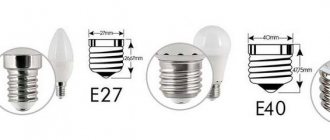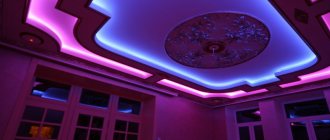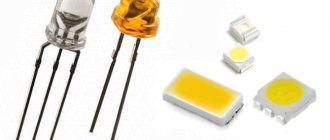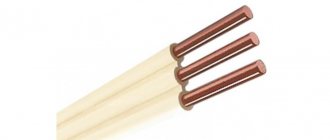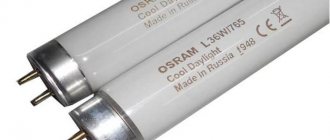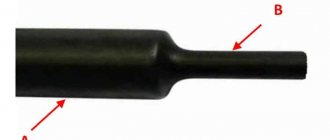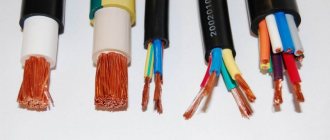Even though LED strips appeared on the market not so long ago, they have already managed to occupy their segment. These are new and slightly non-standard lighting devices, which are usually used for the purpose of decorating premises or creating outdoor advertising. They can be used to illuminate niches, openings and multi-level ceilings.
Today, LED strip can easily become a replacement for sconces and chandeliers that are found in every home. It is not surprising that the question arises: “how to choose an LED strip?” This is an economical solution. Diodes do not use much electrical energy, but they shine quite brightly.
When choosing, it is important to choose the right type of LED strip, as well as calculate the luminous flux power that is needed in a given situation. This is what we are talking about in our article, which will certainly be useful to you in this case. Let's begin!
List of manufacturers: which brand to choose today
It is worth recognizing that today CD tapes have reached the peak of interior fashion. It is not surprising that many companies were interested in their release. These include popular brands that everyone knows, as well as little-known organizations from China. CD tapes are not complicated. They are reliable in use, so even at a price that is acceptable to you, there is a chance to find the best option that will delight you with functionality for years to come. But keep in mind that if you don’t want to play the lottery when choosing a good tape, then it’s better to pay attention to options from Russian or European manufacturers.
You will receive in return high quality LED strips if you buy products from the following brands: LEDCraft; Sveteco; JolietTechnologies; Arlight or Cree.
Check the voltage at the tape connection point
After installing and connecting the LED strips, it is advisable to check the voltage at all connection points of the strips; it should not be lower than 22.5 volts. The measurement must be taken after 10 minutes of operation of the tape at maximum brightness. If the voltage on the tape is lower, then you need to check the quality of the connections of the cables and the tape and the cables and controls in the panel, and the voltage at the output of the power supply.
If the cable is poorly clamped into the ferrule-sleeve, or not all the “hairs” are soldered to the tape, or the terminal block in the connection is not screwed tightly, then the problem area will heat up and the voltage on it will sag.
If you have a lot of tapes or you constantly install them, it may make sense to purchase a pyrometer or even a thermal imager to immediately see problem areas. The thermal imager is also useful when building a house and analyzing heating performance, so it will come in handy. If you see that some place in the connections of the tape is heating up more than others, you need to check the quality of this connection, and, if necessary, tighten it, tighten it, and solder it. And it makes sense to sometimes look at the electrical panel with a thermal imager in search of heating spots, after first turning on more devices and waiting until it warms up.
A separate issue is the connection of controllable LED strips in the switchboard. The advantages of the tapes can be connected to a cross-module or to a distribution block. After some time I will have photos of the implementation of such connections, I will definitely share them.
100, total, today
Related posts:
- Dimming lighting from a Smart Home Let’s touch on the topical issue of dimming lamps from the Smart Home system, especially...
- Selection of Wirenboard equipment and system design I’ll tell you a little about how to design a Smart Home system on…
- Cables for LED strips I’ll tell you about one important point, namely how...
- Placing power supplies for LED strips Continuing the topic of high-power LED strips, I’ll tell you how...
- Cable installation for a Smart Home As I already wrote, the most unreasonable way to save money in construction...
- Connecting motion sensors to a Smart Home Let's consider all possible options for connecting a wired motion sensor to the system...
- Dimming LED lamps I’ll be honest: although I am a supporter of LED lamps, when...
Features of operation and design of the CD tape
When choosing which LED strip to choose for illumination, it is important to understand what the design is. This is a flexible board with a solid base that has a number of diodes that are soldered to it. Their location is clear - all diodes are located at an equal distance from each other. This is an important parameter that allows you to create uniform light dispersion.
The board is connected to a special type of power supply. It supplies the LED area with a voltage of 12-24 V, due to which a decrease from 220V occurs. The tape can be equipped with a self-adhesive layer to simplify installation, or it can be placed in a transparent type polymer tube. Each tape comes with contact pads, which allow you to increase the length and assemble a chain from individual pieces. In accordance with them, you can trim the flexible “lamp” in order to obtain short strips. They are connected to each other by soldering or an LED connector, which is an even more civilized method.
For installation, ultra-thin tape is optimal. It is no more than 8-10 mm in width, and 3 mm in height. This makes it possible to install LEDs even in places where it is not so easy to get to. This minimizes the loss of space.
LED strips do not consume much energy, but they provide quite a decent amount of light, which allows you to fully illuminate the room.
How are LED strips produced by LEDRON labeled?
The Moscow company LEDRON is a relatively new participant in the lighting devices market in the Russian Federation. But despite this, deciphering the markings of its LED strips provides a lot of information.
In notation, the company uses a system of six elements.
Example. The marking of the LED strip model D8280DW 34 mm 4000K contains six elements:
- The letter D means a series of products.
- Number 8 is a subseries.
- The number 280 is the density of LEDs on one meter of the board; it can have two or three digits, for example, 60 or 120.
- The letters DW are an abbreviation for the English phrase denoting the shade of white luminescent light - Day White or day white, color temperature range 4000-5000K.
- 34 mm – width in millimeters.
- 4000K – color temperature value.
Product labeling is an important element that provides information about it. Used correctly, it makes working with the tape easier.
Brightness
The lighting power indicator is indicated by a special index. It is presented as 4 digits. Relying on it, you can determine the quality of the glow of the tape and its brightness indicators. Today, under this parameter it is customary to distinguish several types of diodes. We propose to talk about them in a little more detail to bring you up to date.
3528
CD tapes with this marking are not popular in our country. This is due to the fact that the glow power indicator varies within 4.5-5 lm, but no more. SMD devices can be used in decorative finishing. For example, shelves, ceilings, wardrobes, or is often used to decorate a work desk in the kitchen.
When thinking about which LED strip to choose for the kitchen or another room, it is better to look for other options. The same power is enough for installation as auxiliary lighting in conjunction with other lighting devices. But this option will not be appropriate as an independent light source due to the weak glow and subdued light dispersion.
5050
These tapes have analogs - 5055, 5060. They are much more common. In terms of characteristics, they do not differ from each other, but only the fact that in analogues the diodes are slightly longer can be distinguished. The luminous flux is within 12-14 lm.
In general, such lamps are distinguished by their bright properties. They can be used as a decorative or auxiliary device, as well as the main source of lighting in the room. If you have chosen an LED strip to provide the main lighting in the room, then take into account that for 8 sq.m you need to provide 5 m.
2835
Continuing to study the question of which LED tape to choose, do not forget about option 2835. It is equipped with bright 24-28 lm diodes. The tape has a narrowly directed stream of light with high power, if we compare it with the options listed above. For this reason, it is often used to organize complete lighting of rooms. The calculation is as follows: 12 sq.m. needs 5 m of LED tape.
But the decorative features of this option are weak. On the contrary, bright light can highlight the disadvantages of the interior, and even when you are in the room you will feel how it hurts your eyes. In general, in rooms with spacious features, the problems mentioned above can be avoided by using SMD options.
5630 (5730)
By marking we mean diodes with bright and powerful properties. Tapes are often used as the main lighting in office premises, shops or premises with a large area.
LED strips provide 75 lm of light flux. In this case, the diodes heat up quite strongly, for this reason experts do not recommend installing them in the area of an aluminum profile or polymer stretch ceiling.
Classification of LED strips.
- Svetoyar
- Good to know
- Classification of LED strips.
According to the degree of protection against dust and moisture (IP).
Each LED strip has a certain degree of protection from dust and moisture.
Today, the following protection classes are common: IP20, IP22, IP33, IP65, IP67, IP68. Classes IP20, IP22, IP33 usually refer to the same LED strip; each manufacturer assigns the degree of protection in its own way and, apparently, without conducting proper tests. Essentially, this is a diode strip with open diodes and resistors installed on a flexible printed circuit board; an image of such a strip is shown in Fig. 1.
Rice. 1. Section of an open type LED strip (IP20, IP22, IP33).
Diode strips of this type are used in dry rooms and with a low probability of mechanical damage. Among the conveniences of such a tape, it is worth noting the ease of soldering and the ease of connecting connectors (special clips for connecting tapes and supplying power wires). Therefore, if there is a need to frequently cut such a tape and solder a lot, then this type of tape is preferable, for example, for illuminating display cases, cabinets and complex interior elements with a large number of segments. The cost of such tape is low, which makes it popular.
Diode strips with protection class IP65 are completely protected from dust and from jets of water flowing from all sides. The tape is coated with a layer of compound (silicone is most often used) fig. 2a, there is also a version of the LED strip completely enclosed in a silicone tube, Fig. 2b. This tape can be installed in rooms with high humidity. But this tape is also interesting for dry rooms, since it is more convenient to stick on. You can iron it along its entire length, and after this LED strip has been working for some long time, you can easily wipe off dust from its surface with a damp cloth.
Rice. 2. Section of a closed type IP65 LED strip filled with silicone compound.
Rice. 3. Section of a closed type IP65 LED strip in a silicone tube.
Protection class IP67 is a tape in a tube filled with silicone inside the tube; a section of the LED tapes is shown in Fig. 4. This LED strip is one of the most resistant to moisture. Full protection against dust penetration, short-term immersion to a depth of 1 m is permissible, but continuous operation over long periods of time
Rice. 4. Section of a closed type IP67 LED strip in a silicone tube and with silicone filling inside the tube.
Immersion in water is not intended. This diode strip is ideal for outdoor use, most often used for contour lighting of buildings, for decorative lighting of landscapes and rooms with very high moisture levels: bathrooms, showers, saunas, near swimming pools.
LED strips with protection class IP68 (long-term immersion to a depth of more than 1 m) are quite rare, although many manufacturers often declare IP68 (usually on diode strips with a supply voltage of 220 Volts. We recommend that you be wary of strips with this protection class since manufacturers often overestimate given value.
By supply voltage.
LED strips have a constant supply voltage: 5V, 12V, 24V, 36V or alternating 220V.
Thanks to such a low voltage, a 5V powered tape is the safest. It can be used in lighting clothing, furniture and the manufacture of consumer goods.
LED strips with a 12V power supply are considered the most common and practical to use. Most often, it is installed in residential premises for decorative lighting; it is used to illuminate cornices, niches, building outlines, and also illuminate shop windows and small rooms. It is also common among car enthusiasts for tuning.
LED strips with a supply voltage of 24V have half the current than a 12V strip with the same power. As a result, such tapes reduce the load on the current-carrying parts of the printed circuit board. For the same reason, we can use a cable with a smaller cross-section for power supply than for 12V tapes. The power supply will be more compact for 24V LED strips than a 12V power supply of the same power. Amplifiers, dimmers and controllers can be loaded more with a 24V LED strip than 12V. General conclusion: it is beneficial to use a 24V strip if we have a high system power, then it is easier to select controllers, amplifiers and dimmers, the power supplies will be smaller in size, and the wires will have a smaller cross-section . There is a myth that a 24V tape is brighter; this is really a myth that has no physical basis.
LED strips with a supply voltage of 36V are quite rare; their main advantage is similar to the 24V strip in the ability to use wires with a smaller cross-section, smaller power supplies, and controllers and dimmers with higher power. The disadvantage of such a tape is its low prevalence and the rarity of power supplies (drivers), controllers and dimmers operating with a voltage of 36 V.
The 220 V strip is connected directly to the household electrical network. It is designed for street use. Be careful, it is highly undesirable to use this LED strip in a residential area, because the strip has flickering that can irritate the eyes. The cutting ratio of such a tape is 1 meter, which will not always be convenient, unlike tapes with constant voltage power supply (12 V, 24 V) for which the cutting ratio will be 3 - 15 cm. A 220 V LED strip is good to use as a New Year's street decoration, This tape is often used to illuminate the contours of buildings, illuminate advertising signs, and variously illuminate decorative structures.
By type of diodes and luminous flux.
The luminous flux value depends on the type of diode and the number of diodes. There is a numerical standard for designating surface-mount LEDs, which often also designate strips made using these diodes. And so, for the production of LED strips, the following LEDs are used: 3528, 5050, 5060, 5630, 2835, 3020 and others; these numbers indicate the dimensions of the diode body. So, for example, a diode of type 3528 has a size of 3.5mm * 2.8mm. An LED in a 3528 housing has more power and a higher luminous flux than a 5050 diode; it is easy to guess that with the same number of diodes, a strip with 3528 diodes will have less luminous flux than a strip with 5050 diodes. Therefore, when choosing an LED strip, you must first of all, pay attention to the luminous flux from the LED strip, and not to the number of diodes.
By class.
LEDs are conventionally divided into 3 classes - economy, standard and premium. Premium class diode strips use the most efficient LEDs (high luminous efficiency), and the highest quality materials such as: printed circuit board, packaging. Typically these tapes have higher solder quality. Economy class tapes, on the contrary, have less efficient LEDs, and the printed circuit board and other elements are of lower quality. Standard class tape is an intermediate value between economy and premium classes, the so-called golden mean.
In the direction of the glow.
Horizontal glow tape. This is a classic strip light propagates from the surface of the LED strip at an angle of 120 degrees, drawing in Fig. 5 a. This type of diode strips is the most popular and is used in lighting ceiling cornices, building contours and other areas.
Side glow tape. Light propagates parallel to the plane of the printed circuit board, drawing in Fig. 5 B. This type of tape is usually used in advertising structures.
Rice. 5a. Cross-section of LED strip.
a) Horizontal glow of the diode. b) Side glow of the diode.
Tape for strong bends. Such an LED strip is capable of bending in all directions, this is achieved thanks to the design of the printed circuit board with sharp bends, this can be seen in the photograph Fig. 6. Thanks to this design, it is quite easy to illuminate interior elements with strong bends.
Rice. 6. LED strip for strong bends TM Arlight.
By the color of the glow.
There are single-color and multi-color diode strips
Single-color ribbons emit white, red, orange, yellow, green, blue, violet and ultraviolet light, with white light being warm, neutral and cool.
Multicolor tapes are divided into RGB, RGB+white and MIX tapes. Let's look at each one separately. RGB – the tape is made on the basis of 3 crystal LEDs, each crystal emits its own color, R – red, G – green, B – blue. When these colors are mixed with different intensities, we get any other color, such as purple or pink.
RGB+white is an RGB LED strip with a separate white LED, this is done to produce high-quality white light, since in practice the RGB LED strip does not produce clear white light, it usually has a sharp tint in the blue or purple region.
MIX - the tape consists of warm white and cool white LEDs. Thus, it becomes possible to easily adjust the light to your psychological state. Warm white light promotes a calmer, sleepy environment, while cool white light is more invigorating and encourages activity.
Conclusion. Of course, this article does not cover all types and classes of LED strips; only the main ones, which represent a cross-section of the market at the beginning of 2015, are considered.
22.11.2017
Protection indicator
An equally important criterion that should be taken into account when deciding which LED strip will be used for the ceiling or walls is the level of protection from moisture and dust.
ip20 is the cheapest open tape available. It can be used in bedrooms, children's rooms, halls or living rooms. Those. in areas where it is dry and clean.
ip23, ip43, ip44 – has a much more serious level of dust and moisture protection. Due to this, LED strip can be used in rooms where there is dampness and no heating. Those. loggia. It can be installed on the baseboard or on the floor surface.
ip54, ip65, ip68 - sealed tapes are presented that are hidden in a silicone cocoon. Their installation can be carried out in rooms where there is a high level of humidity. Application is possible even in the case of external lighting. The level of protection of the LED strip allows it to work perfectly even at temperatures of -25..+60 °C.
power unit
To ensure diode lighting operates correctly for a long time, you need to select an appropriate power supply. It comes separately from the kit, and therefore you should also include this purchase in your list of expenses.
The power supply should be selected based on the length of the tape, as well as the amount of electricity consumption per linear meter. Those. you need to multiply these values and round the result, leaning upward.
The power indicator depends on the location of the chips, or rather their density. The intensity of the luminous flux that they produce is also important. For example, SMD tape 3528 has 60 diodes per 1 m, it consumes 4.8 W. But the 5050 version produces 15 W at the same density values.
Count currents and voltage drops
Just today, an installer wrote to me who is laying a cable according to my project. He wrote “to illuminate the kitchen, let’s not pull the power cable to the power supply in the closet, but place the unit in the panel and run a low-current cable.” This is a very common point of view. Unfortunately, it is common among electricians. Those same “ordinary electricians” that I wrote about. Since 230 volts generate current, you need a thick cable, but 12-24 volts do not generate current, so you can run them with a thin cable.
Cable thickness is determined by current, not voltage! Only with electric shock! The thickness of the insulation is determined by the voltage, for example, 230 volts cannot be carried over a twisted pair (although the cross-section allows for a small current to be carried), because the insulation is not designed for such a voltage - some electricians should also be told about this.
Let me remind you: power = voltage * current. Power is measured in watts, voltage in volts, and current in amperes.
For each LED strip, we need to calculate the current and voltage drop in the cable feeding it.
First we count the current. On each LED strip it is written what power it has. Let's say we have an LED strip of 9.6 watts per meter, a length of 10 meters, a total of 96 watts. The voltage is 24 volts, which means the current is 4 amperes. It seems that the current is small, so there is nothing to think about, can you lay a cable with a cross-section of 0.75? No, when we talk about low-current loads, we must also take into account the voltage drop. Voltage drop is a decrease in voltage on the cable, that is, the device will receive a voltage less than what came out of the power supply. The voltage drop is present in all cables, but if 230 volts came out from the switchboard, and the load is 220 volts, then this will not be noticeable. But if 24 volts came out, and 21 volts came in, it would be noticeable by the brightness of the tape. If you have a 12-volt electromagnetic lock on your gate, a power supply in the house, and a cable with a cross-section of 0.75 is several tens of meters long, then the lock may hold much worse, since it will receive less than 12 volts. Therefore, it is important to calculate the voltage drop in the cable when dealing with 12 and 24-volt devices.
The thinner the cable, the greater the voltage drop. The greater the current, the greater the voltage drop. Read more about the calculation in the article Cables for LED strips, where you can also download a table in Excel for calculating the drop. The KNX or RS485 bus can be longer with minimal voltage drop because the current consumption of the devices is very low. It’s the same with different types of sensors - the current is small, so the voltage drop is also small, even despite the thin cable.
Here is a tape calculation table from one of my projects:
For each tape, the current and voltage drop as a percentage are calculated, based on the length and cross-section of the cable, as well as the power density and length of the tape. It is calculated in such a way that the voltage drop does not exceed 8% anywhere. With a drop of 10% this becomes noticeable. As a last resort, you can slightly increase the voltage on the power supply (many have an adjusting screw). But it’s better to play it safe in advance and lay a thicker cable, or several cables.
The website Transistor.ru has calculators for various calculations, including the voltage drop in the cable. Very comfortably.
Controller: determining the optimal type
This device is needed to control the functioning of RGB strips of different colors. Its main task will be to change colors, saturation and brightness of the hue, relying on commands from the remote control or the program. The controller is located in the area between the power supply and the tape.
Today, several types are known:
- No remote control. This option is cheap and simple. It has a built-in program that controls the smooth change of shades.
- IR remote control. The settings are much more solid. The controller itself must be placed in an area where the remote control “sees” it. The price of the device will depend on the number of built-in options.
- Radio remote control. This controller can receive a signal even if it is in another room. There are a lot of glow settings - almost 10,000 shades, as well as a large selection of different modes.
Sometimes you can find options that operate via Wi-Fi. Management will be carried out using a special application, which must be downloaded to your smartphone. If we talk about functionality, then such devices are no better than radio models, and therefore overpaying for them is pointless.
Your task will be to correctly determine the power data of the controller, relying on the data of the standard series. These are 72, 144, 288 or 180 W. If the power is lower, it means that the device will fail soon, so be careful and do not neglect this parameter.
Protect the benefits of power strips with fuses
But this is an important point. Suppose we have a powerful power supply, for example, 960 watts 24 volts. This is 40 amps. The power supply is of high quality; it can operate for a short time with an overload of up to 150%. Several tapes are connected to the unit at once, but some problem occurs in one of them, for example, the tape is flooded with water or it is partially shorted. If a short circuit occurs, the power supply will see it and turn off (this is called “short circuit protection”; most tape power supplies have it and, of course, all Meanwell units, among which there are models of this power). But if there is no short circuit, but the tape is partially closed, then the unit can supply a current of up to 60 amperes to this tape. With this current, the tape, the cable, and the amplifier will melt, and then short-circuit protection or overload protection of the unit itself will work. If the unit is turned off when the protection is triggered, after some time it will begin to turn on periodically, which is also quite bad.
You can install breakers on 24-volt lines. There are special machines for direct current (several times more expensive than regular ones); on the Internet you can find many discussions about how machines operate on direct current. My opinion is that DC circuit breakers work poorly. Not fast enough. Disconnection must occur instantly; even the minimum delay is unacceptable here. That's why I think fuses are the best option. For a cable with a cross section of 1.5 mm2 we put a 10 ampere fuse, for a cable with a cross section of 0.75 mm2 we put a 5 ampere fuse. We use the simplest fuses, 5x20. Such a blister of 10 pieces costs 120 rubles in Chip-Dip. You can find it cheaper on radio markets.
The fuses say “250 volts”, this does not mean that it only works with this voltage, it means that 250 volts is the maximum voltage for it. The fuse trips when the current is too high. The wire inside it is the thinnest point in our cable from the power supply to the tape; it will burn out first if the current is exceeded.
The fuse is conveniently inserted into the terminal on the DIN rail. The width of the ABB terminal is 8mm, the fuse is easily removed, you can quickly turn off the circuit by removing the fuse.
I have such fuses in my projects to protect all low-current cables coming from the switchboard: power supply to all drives and sensors, bus power supply. ABB has a model M 4/8.D2.SF with an additional feed-through second contact. There is a model M 4/8.D2.SFD with a 24-volt LED, which is used to monitor the integrity of the fuse and the presence of power.
A cheaper and simpler option is a regular fuse holder; it can be connected anywhere on the cable.
Such 1.25 ampere fuses are even included with Fibaro Dimmer dimmers so that you don’t forget to install them. In our case, the fuse rating is selected based on the maximum permissible current for the cable, possibly adjusted for the maximum current of the dimmer or amplifier.
When buying fuses, remember to spare. If you need 5 pieces, then buy at least 10, and preferably 20. It happens that by the time you figure out a problem, a dozen fuses have already burned out.
The fuse for each cable is convenient for us because it will immediately turn off the problematic branch, everything else will continue to work.
By the way, we put the fuse on the positive power supply of the tape.
Types of CD tapes
Monochrome SMD
SMD LED strips are the most popular in our country today. They are priced lower than their analogues. Abilities allow you to produce a blue, red, yellow or green glow. There are also intermediate tones. For example, orange, purple. Those options that come in white give you the opportunity to choose any of the three shades. It can be neutral, warm or cold.
The color of the tape will vary due to the color of the crystals used in LEDs. By the way, there are no white people there. To obtain a natural glow, it was decided to apply a phosphor to a blue crystal. This is the technology that manufacturers use. But keep in mind that over time the coating will still fade, and therefore the tape will show its natural color.
Main advantages
- a solid variety of shades;
- compact size and ease of installation;
- availability of tapes of different capacities;
- energy consumption is economical;
- will last a long time;
- can be used as an independent light source;
- reasonable price.
Main disadvantages
- very often there are fakes from China that are not of good quality;
- products from famous brands are very expensive;
- if you choose the wrong color, it will spoil the impression of the created picture of the interior.
Multicolor RGB
When illuminated, RGB strips can produce thousands of different shades. There are crystals of 3 main colors. These are green, red, blue. You can mix them in certain proportions, and you can get a shade that you like.
A special controller is capable of changing and combining colors; it is responsible for regulating the saturation, intensity, and brightness of the diodes. Due to this, RGB strips operate in cyclic color changing mode, flicker, or correspond to the “treadmill” principle.
Main advantages
- variety and brightness of shades;
- saturation;
- you can automatically change the color or turn on a “special effect”;
- economical consumption of electrical energy;
- Setting up from the remote control is simple.
Main disadvantages
- RGB strips cost twice as much as monochrome options;
- cannot be used as the main lighting in the room.
By using multi-color LED tapes, you can decorate your house not only inside, but also on the outside. You can also highlight a car or a billboard. But all this is possible if you have tapes with an excellent degree of protection from moisture and dust at your disposal.
Assessing the quality of the CD tape
Not even all professionals can evaluate the quality of LEDs, let alone us, ordinary consumers. This is what dishonest manufacturing companies are trying to recoup on, trying to fill the market with rubbish. But don't despair. There is an exit. There are secrets available that will make it possible to understand what the quality of the product really is.
Make sure the LEDs and resistors are aligned exactly. Also evaluate the protective coating; it should be applied evenly. The edges of the tape should be smooth.
It is important that there is a logo from the manufacturer. Resistors can have a voltage resistance of 150 - 300 Ohms. The marking can be represented by 151-301. If the tapes are not of high quality, then the indicator will be indicated only by 100 Ohms.
The brightness of the diodes at different edges of the tape is the same. All diodes produce light of the same temperature, but this parameter can be assessed by looking at the tape with sunglasses. Bend the tape at 60 degrees and then release. It will still retain its bend for some time.
It is likely that this tape is of high quality, the power supply is installed correctly, everything matches, but after a couple of months of operation the diodes will begin to fade. Please note that the manufacturer may indicate that the CD tape will last for a decade. But this is possible if the heating is no more than 400 C. If you leave it on for a long time, the temperature will be increased to 800 C. In this case, the diodes will begin to “age” much faster. Brightness levels will be reduced by 2 times after 50-80 hours. Those. You shouldn’t skimp on purchasing special aluminum profiles that have a transparent lid. Thanks to them, heat can be effectively removed from the tape. However, keep in mind that their cost is not small.
Steel profiles are much cheaper. But don’t forget that their efficiency is lower than that of the aluminum version.
Plan your tape connection points in advance
Tapes longer than 5 meters are connected to the power supply at both ends (if they are not weak tapes of 5 watts per meter, there are no such problems with them), otherwise the voltage on the tape itself may drop, and it will be less at the end diodes. And the next piece of tape cannot be connected to a 5-meter piece of tape; for the same reason, the next piece must be powered from a separate cable. And if we have 15 meters of tape, then we need to connect the power at three points: from the edges and in the middle.
Tape connection diagrams from the instructions for Arlight tapes
We have two options for connecting a powerful tape that needs to be powered at several points. The first option is to pull several cables from the switchboard, and in the switchboard we already carry out switching of these cables. The second option is to pull one cable of the required cross-section from the shield to the distribution box somewhere at the beginning of the tape, and in the box from this cable we route several cables to the connection points of the tape. I personally don't like hidden mounting boxes, so I prefer the first option. But for some, the second one, with boxes, will be more convenient. And the third intermediate option - without boxes, but with jumpers.
Let's give an example. Suppose we have 20 linear meters of tape around the perimeter of our room with a power of 19.6 watts per meter, 24 volts. Total 196 watts, 8.17 amps. Power must be connected to the tape at 4 points, every 5 meters. If we want to place the tape power supply in a shield, let's estimate the average length of the cable from the power supply to the connection point. Let it be 15 meters.
Next, we calculate the voltage drop based on the cable length, cable cross-section, current, and cable resistivity. If the cable has a cross-section of 1.5mm2, then the voltage drop will be 11.6% - a bit too much, it will be noticeable. We select the cable cross-section and the number of cables. If you lead from the switchboard 4 cables with a cross-section of 0.75mm2 (that is, a total cross-section of 3mm2), then the voltage drop will be 5.8%, this is already better. You can get the same voltage drop figure if you stretch two 1.5mm2 cables and power two corners of the tape rectangle from each cable. You can go with the second option - stretch one cable with a cross-section of 4mm2 to the distribution box, from it the shortest possible jumpers to the power points of the tape with a cross-section of 1.5 or even 0.75. Before the distribution box, the voltage drop with a cable length of 15 meters will be 4.3%; if the jumpers are short and securely soldered to the tape, there will be no problems with their cross-section of 0.75mm2.
The thinner the cable fits the tape itself, the more convenient it is to connect. For example, 0.75mm2 is convenient to connect, but 1.5mm2 is not so much.
That is, in our example, you can do it in three ways:
- Extend 4 0.75mm2 cables to the tape (without intermediate boxes, the most convenient connection). Plus - no box. Minus - 4 cables to pull and insert into the shield.
- Stretch one 4mm2 cable to the junction box, from the box 4 0.75mm2 cables to the corners of the tape. Plus - less voltage drop. The downside is the presence of a box.
- Stretch two 1.5mm2 cables and power the strip with jumpers. Plus - only two cables of small cross-section. The downside is that it is inconvenient to make a jumper, because you need to connect the cable, tape and jumper suitable from the switchboard at one point.
In each option, it is necessary to calculate the voltage drop so that before the tape it is no more than 8%, and preferably no more than 6%.
Advantages and disadvantages of CD tapes
One of the advantages is the fact that the LED strip produces very high brightness levels, but at the same time ensures minimal energy consumption. It is also convenient that installation can be carried out even in places where it is quite difficult to get to. The tape will not take up useful space, and the installation itself is quite simple.
A high-quality tape under the right conditions of temperature and moisture will last exactly 20-50,000 hours. But low-quality options from unknown manufacturers will fail in the first year of use.
If the LED burns out, then 3 diodes will stop lighting, but not all. This is due to the design features of the tape. At the same time, the advantage is that LEDs are not afraid of low temperatures or shocks. With their help, you can create very interesting lighting ideas. For example, equip the effect of a floating ceiling, which looks simply amazing indoors. Moreover, today there are a number of options on the market where the sections have different colors. In some of them you can change the brightness and color.
There are still some disadvantages. But they are not significant. One of them is that it is important to use a power supply and it must be purchased separately, as already mentioned in our article above. But another drawback is that after 20-50,000 hours, the brightness indicators will begin to decrease.
No. 7. Wire selection
Even if you buy a high-quality tape and a suitable power supply, the system may not work reliably due to the thin wire. Only copper wire should be used, and the cross-section is calculated based on the rule: for every 10 A of voltage, 1 mm2 of wire cross-section is required.
How to find out how much current the tape consumes? First you need to calculate the total power. For 5 m SMD5050-60 tape this is (14.4 W/m * 5 m) = 72 W. The current can be obtained by dividing the power by the voltage. It turns out, 72 W/12 V = 6 A. Based on the rule for calculating the wire cross-section, we get 6/10 = 0.6 mm2. The closest standard cross-section value is 0.75 mm2. If the power supply is located at a distance of 5 m or more from the backlight, then it is better to take a thicker wire - from 1.5 mm2.
Some experts recommend selecting wires based on the parameters of the power supply. The idea is that the adapter can easily withstand voltage surges, but a thin wire may not be able to cope, so you need to take a cable that can withstand 135% of the rated current for which the power supply is designed.
Everything described above concerns connecting the tape to the block. The power supply itself is connected to the network using a regular 220 V cable.
Expert advice: which CD tape to choose
If you plan to decorate shelves or racks, then use SMD tapes 3528; as for the shade, it can be anything. You don't need to strive to provide a high power tape. The optimal solution would be to go with 60 diodes per 1 sq.m.
To equip a bedroom or children's room, it is better to buy SMD 3528 or 5050 as additional lighting. But again, pay attention to the soft white glow - a neutral or warm shade.
To organize additional lighting or replace the main one in the hall, living room, large rooms, it is better to use LED strips, the power ratings of which are 2835 or 5050. These are bright diodes that will cope perfectly with the options of traditional lamps.
If the task is to equip street display windows, an office or a store, it is better to choose SMD 5630-5730, which has powerful diodes with high brightness. It will not be difficult for them to provide lighting to a large perimeter.
But for avid car enthusiasts who want to stand out from the gray mass, you can buy SMD 5050 or multi-color RGB tape for illumination. Just pay attention that the protection level is not lower than ip54. For a sign for a cafe or other establishment, choose multi-color RGB tapes in a silicone shell. But it is better to take the level of protection higher than ip65.
